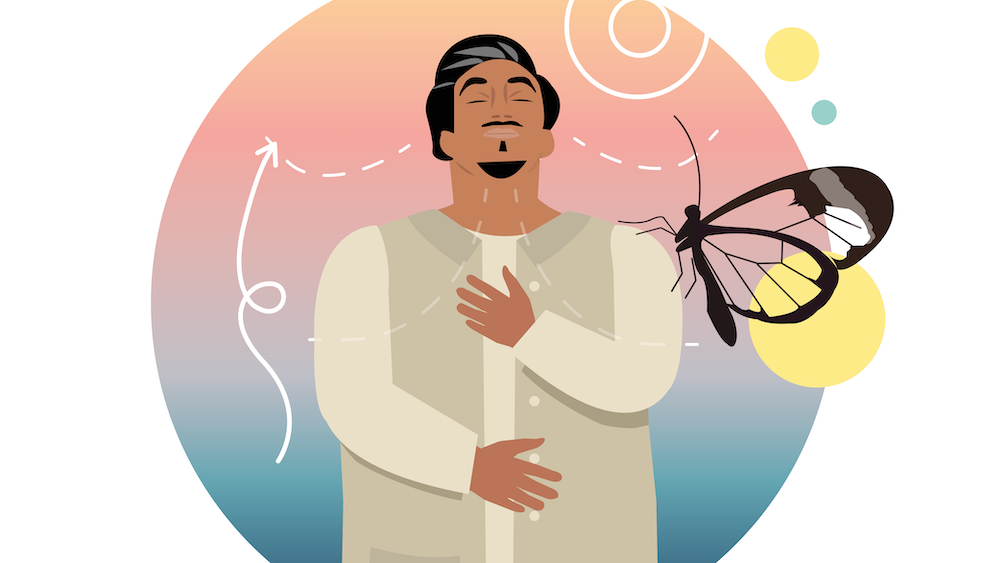Twenty years ago, Alan Dolan quit a career in aerospace PR to build a business based on oxygen. Now the founder of Breathguru, here he explains how inhaling and exhaling can boost your health, happiness, and bring emotional peace
Breathing – it keeps us alive, but most of us barely notice it happening. It’s pretty astonishing, considering resting adults inhale and exhale up to 23,000 times a day – that’s more than eight million times a year.
The rewards of good breathing are well understood. The Buddha credited breath-meditation as a route to enlightenment, and research has shown that slow, deep breathing can help combat anxiety, depression, and medical problems such as high blood pressure.
In recent years, breathwork – a form of active meditation where the breathing pattern is intentionally changed to achieve a host of benefits – has gained momentum. This year, the Global Wellness Summit cited breathwork as one of its top wellness practices of 2021.
One technique is Conscious Connected Breathing, a deep diaphragmatic breathing practise that places greater emphasis on the inhale to the exhale, and uses the entire respiratory system to infuse the body with healing oxygen and energy.
And, according to international breathwork practitioner Alan Dolan, our breath mirrors our behavioural patterns, so through Conscious Connected Breathing, we could potentially transform how we think, feel, and live.
“Think about how we breathe as being ‘life’. How we breathe is how we are doing life,” explains Alan. “About 80% of us are upper chest breathers, and if somebody’s inhale is compromised, that often relates to their ability to receive. They’re great at giving, but maybe they’re used to de-prioritising their own needs, and not receiving all that they could.

“If somebody overemphasises the exhale, and breathes from the belly, like 20% of us, that tells me that there’s an overemphasis on the negative or on lack. What’s mind-blowing is when you tweak the breath pattern, the corresponding behavioural pattern also changes.”
Since launching his company, Breathguru, 17 years ago, Alan now estimates he has taught more than 15,000 people to consciously connect to their breath, including comedian Russell Brand, actress Naomie Harris, plus scores of high-flying CEOs.
Brilliantly, no equipment is required. Simply lie down, place one or two hands on the navel, and with the mouth wide, an exaggerated, long inhale is followed by a short, sigh-like exhale. The continuous flow of breathing is repeated on a loop for at least 10 minutes.
“What differentiates it from other forms of breath work is the breath is always in motion, and that’s what puts the body into an autopilot reset mode. It’s about plugging into our innate intelligence, and letting our bodies do the work for us,” says Alan, adding that the practice “opens the doors to the subconscious”, and as well as sparking physiological results, triggering powerful spiritual and emotional responses as the body clears itself of past pain, trauma, and toxic emotions.
“Think of a pyramid,” continues Alan. “The conscious mind is a tiny bit at the top, and the subconscious is a massive part underneath. It doesn’t matter whether or not you know what the emotional baggage is – Conscious Connected Breathing is not a cognitive way of working, but a bodily-led psychotherapy. It’s simply about expelling toxic energy from the body, and attracting life and light back.”
After he hit 40, Alan quit a high flying job in aerospace PR in the Middle East to retrain as a breath coach, and quickly experienced the powerful benefits of Conscious Connected Breathing, which he says healed his own 25-year battle with depression.
The key to results, though, is the investment of time.
“If you want to see tangible results, I’d say a minimum of 15 minutes daily,” says Alan. “Breathwork is like going to the gym. You’ve got to work at it!”
Alan's top tips
-
Work out what kind of breather you are by placing one hand on your tummy, and one hand on your upper chest. Close your eyes, open your mouth, and inhale deeply. Which hand moved the most? Top – you're an upper chest breather. Bottom – you breathe from the belly.
-
Avoid eating for 90 minutes before a practice. It will be less comfortable doing deep diaphragm breathing with food in your belly.
-
Place a weighty book on your tummy to help keep your attention there while you get used to breathing from the abdomen.
-
The mind doesn’t like change. It wants to keep you static (and safe). By ignoring this, and doing your breathing every day, you will very quickly notice tangible results!
How to try Conscious Connected Breathing
- Lie horizontally on a bed or sofa. Use a pillow to support the nape of your neck. Ensure your torso, neck, and head are aligned, and your chin is pointed to the ceiling to allow the throat to really open.
- Close your eyes and mouth, and turn your focus inwards. Breathe in and out through the nose.
- Take your attention from your head, through the body, torso, hips, pelvis, legs, and to your feet.
- Bend the knees, and put your feet flat on the bed or the sofa. Feel the connection of the soles of your feet to the surface, and allow yourself to be supported.
- Place one or both hands on the lower abdomen, just below your navel.
- Open your mouth – wider than you think is necessary – and inhale deeply into the lower abdomen. Imagine you’re inflating a balloon in your belly. Use your abdominals to inflate the balloon.
- Deflate the balloon by exhaling through the mouth with a short, soft sigh. Imagine you’re fogging a mirror. There should be no squeezing, tightening, or crunching of the abdominals
- Keep this breathing going for five minutes, with no pauses between the inhale and exhale. Feel your tummy rise and fall. Keep your attention on the inhale. Suck in the most oxygen and energy that you can. This is your fuel. Then let it go.
- Whatever you notice – sensations around the throat and top of the head, or thoughts in your head – allow them to be there, but keep focused on your breath.
- After five minutes, pull your feet back to your bottom. Place your palms flat on the sofa or bed, and very quickly tap your palms and feet soles on the surface as though you’re jogging. Add in sound while you inhale and exhale.
- After one minute, relax your arms and feet. Return to the open mouthed breathing – a pronounced inhale followed by a short, sigh-like exhale.
- After five minutes flip on to your tummy. Lose the pillow. Place your arms by your sides and continue with a more gentle pronounced inhale and light exhale. Keep it flowing. Feel the inflation of the tummy against the sofa or bed beneath you. Continue for two minutes.
- Now close the mouth, and continue to breathe gently through the nose. Allow yourself to completely relax. Wiggle your fingers and toes, and scan your body from bottom to top.
- Bring your attention back to the room.
- When you’re ready, open your eyes. Always allow five or 10 minutes at the end of the session to relax.
If you’re struggling to achieve a calmer state of mind and are looking for support, speaking to a therapist can help. Visit counselling-directory.org.uk to find the right therapist for you.
Hero Image: Illustration by Rosan Magar


Comments